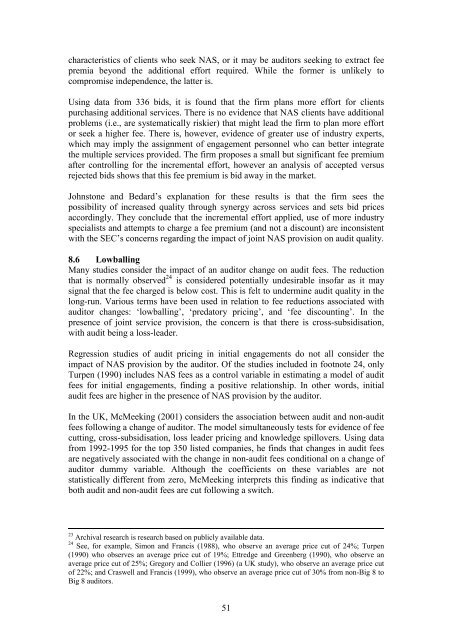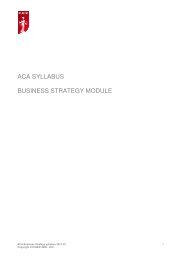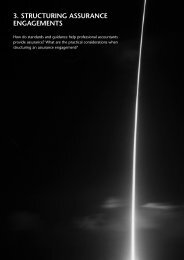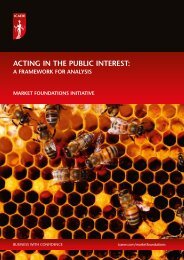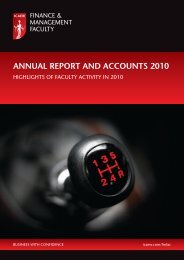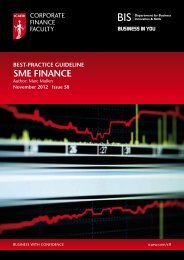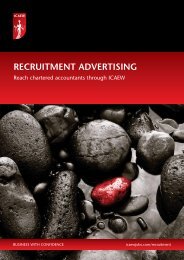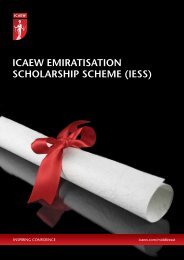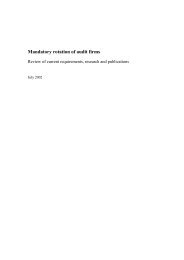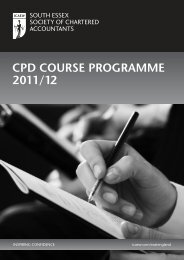Auditor independence and non-audit services - ICAEW
Auditor independence and non-audit services - ICAEW
Auditor independence and non-audit services - ICAEW
You also want an ePaper? Increase the reach of your titles
YUMPU automatically turns print PDFs into web optimized ePapers that Google loves.
characteristics of clients who seek NAS, or it may be <strong>audit</strong>ors seeking to extract feepremia beyond the additional effort required. While the former is unlikely tocompromise <strong>independence</strong>, the latter is.Using data from 336 bids, it is found that the firm plans more effort for clientspurchasing additional <strong>services</strong>. There is no evidence that NAS clients have additionalproblems (i.e., are systematically riskier) that might lead the firm to plan more effortor seek a higher fee. There is, however, evidence of greater use of industry experts,which may imply the assignment of engagement personnel who can better integratethe multiple <strong>services</strong> provided. The firm proposes a small but significant fee premiumafter controlling for the incremental effort, however an analysis of accepted versusrejected bids shows that this fee premium is bid away in the market.Johnstone <strong>and</strong> Bedard’s explanation for these results is that the firm sees thepossibility of increased quality through synergy across <strong>services</strong> <strong>and</strong> sets bid pricesaccordingly. They conclude that the incremental effort applied, use of more industryspecialists <strong>and</strong> attempts to charge a fee premium (<strong>and</strong> not a discount) are inconsistentwith the SEC’s concerns regarding the impact of joint NAS provision on <strong>audit</strong> quality.8.6 LowballingMany studies consider the impact of an <strong>audit</strong>or change on <strong>audit</strong> fees. The reductionthat is normally observed 24 is considered potentially undesirable insofar as it maysignal that the fee charged is below cost. This is felt to undermine <strong>audit</strong> quality in thelong-run. Various terms have been used in relation to fee reductions associated with<strong>audit</strong>or changes: ‘lowballing’, ‘predatory pricing’, <strong>and</strong> ‘fee discounting’. In thepresence of joint service provision, the concern is that there is cross-subsidisation,with <strong>audit</strong> being a loss-leader.Regression studies of <strong>audit</strong> pricing in initial engagements do not all consider theimpact of NAS provision by the <strong>audit</strong>or. Of the studies included in footnote 24, onlyTurpen (1990) includes NAS fees as a control variable in estimating a model of <strong>audit</strong>fees for initial engagements, finding a positive relationship. In other words, initial<strong>audit</strong> fees are higher in the presence of NAS provision by the <strong>audit</strong>or.In the UK, McMeeking (2001) considers the association between <strong>audit</strong> <strong>and</strong> <strong>non</strong>-<strong>audit</strong>fees following a change of <strong>audit</strong>or. The model simultaneously tests for evidence of feecutting, cross-subsidisation, loss leader pricing <strong>and</strong> knowledge spillovers. Using datafrom 1992-1995 for the top 350 listed companies, he finds that changes in <strong>audit</strong> feesare negatively associated with the change in <strong>non</strong>-<strong>audit</strong> fees conditional on a change of<strong>audit</strong>or dummy variable. Although the coefficients on these variables are notstatistically different from zero, McMeeking interprets this finding as indicative thatboth <strong>audit</strong> <strong>and</strong> <strong>non</strong>-<strong>audit</strong> fees are cut following a switch.23 Archival research is research based on publicly available data.24 See, for example, Simon <strong>and</strong> Francis (1988), who observe an average price cut of 24%; Turpen(1990) who observes an average price cut of 19%; Ettredge <strong>and</strong> Greenberg (1990), who observe anaverage price cut of 25%; Gregory <strong>and</strong> Collier (1996) (a UK study), who observe an average price cutof 22%; <strong>and</strong> Craswell <strong>and</strong> Francis (1999), who observe an average price cut of 30% from <strong>non</strong>-Big 8 toBig 8 <strong>audit</strong>ors.51


